Description 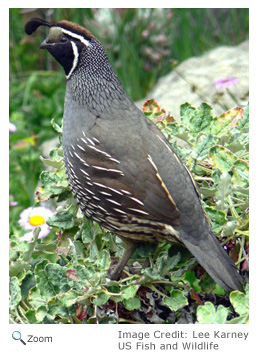 The California quail is a small, plump bird with a short black beak. The male has a gray chest and brown back and wings. It has a black throat with white stripes and a brown cap on its head. The California quail is a small, plump bird with a short black beak. The male has a gray chest and brown back and wings. It has a black throat with white stripes and a brown cap on its head.
The female has a gray or brown head and back and a lighter speckled chest and belly. Both the male and the female have a curved black crown feather on their foreheads. The male's crown feather is larger than the female's. The California quail is sometimes called the valley quail.
Range  The California quail is found from southern Oregon to southern California and east into Nevada. The California quail is found from southern Oregon to southern California and east into Nevada.
Habitat
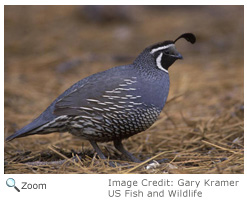 The California quail lives in grasslands, foothills, woodlands, canyons, and at the edge of deserts. It likes areas with lots of brush. The California quail lives in grasslands, foothills, woodlands, canyons, and at the edge of deserts. It likes areas with lots of brush.
|
|
Diet 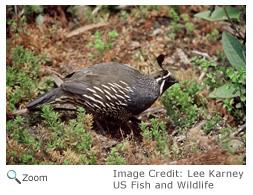 The California quail eats seeds, buds, and sometimes insects. It feeds in flocks in the early morning. The California quail eats seeds, buds, and sometimes insects. It feeds in flocks in the early morning.
Life Cycle 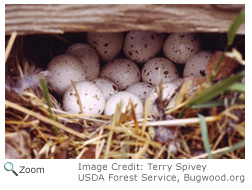 Males often compete for a mate. They mate with only one female. Females usually lay between 12-16 cream and brown speckled eggs. Their nest is a shallow hollow or scrape in the ground that is lined with grass. The female incubates the eggs for about three weeks. Both parents care for the chicks. Males often compete for a mate. They mate with only one female. Females usually lay between 12-16 cream and brown speckled eggs. Their nest is a shallow hollow or scrape in the ground that is lined with grass. The female incubates the eggs for about three weeks. Both parents care for the chicks.
The chicks leave the nest shortly after birth. They make their first attempts at flight when they are about 10 days old. They stay on the ground for about a month and then roost in trees with the rest of the flock. The female usually has one brood a year.
Behavior 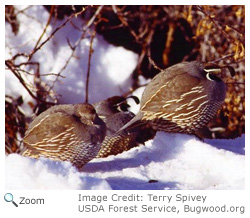 The California quail lives in coveys of 10 to 200 birds in the winter. They stay in these flocks until they pair off during mating season. Male California quails perch on a tree or post and call out to claim their territory. The California quail roosts in trees to avoid danger and to rest. The California quail lives in coveys of 10 to 200 birds in the winter. They stay in these flocks until they pair off during mating season. Male California quails perch on a tree or post and call out to claim their territory. The California quail roosts in trees to avoid danger and to rest.
|



 The California quail is found from southern Oregon to southern California and east into Nevada.
The California quail is found from southern Oregon to southern California and east into Nevada. 


